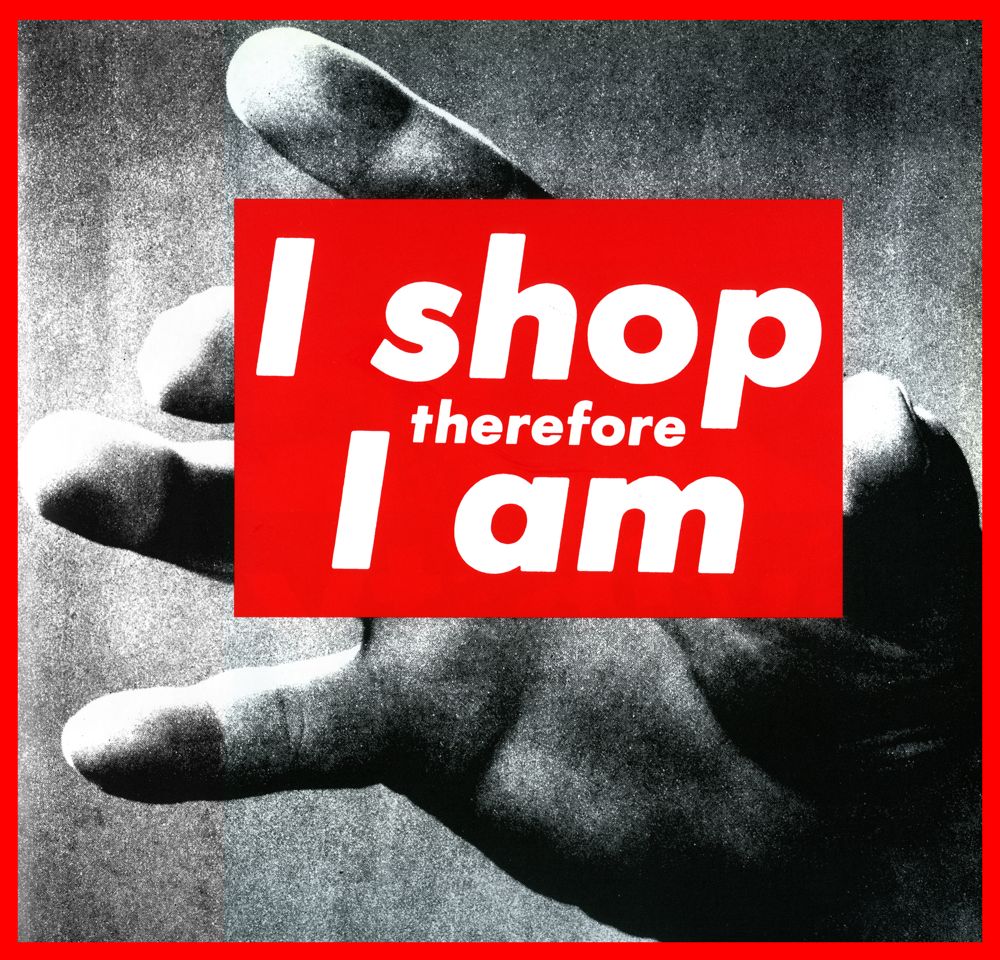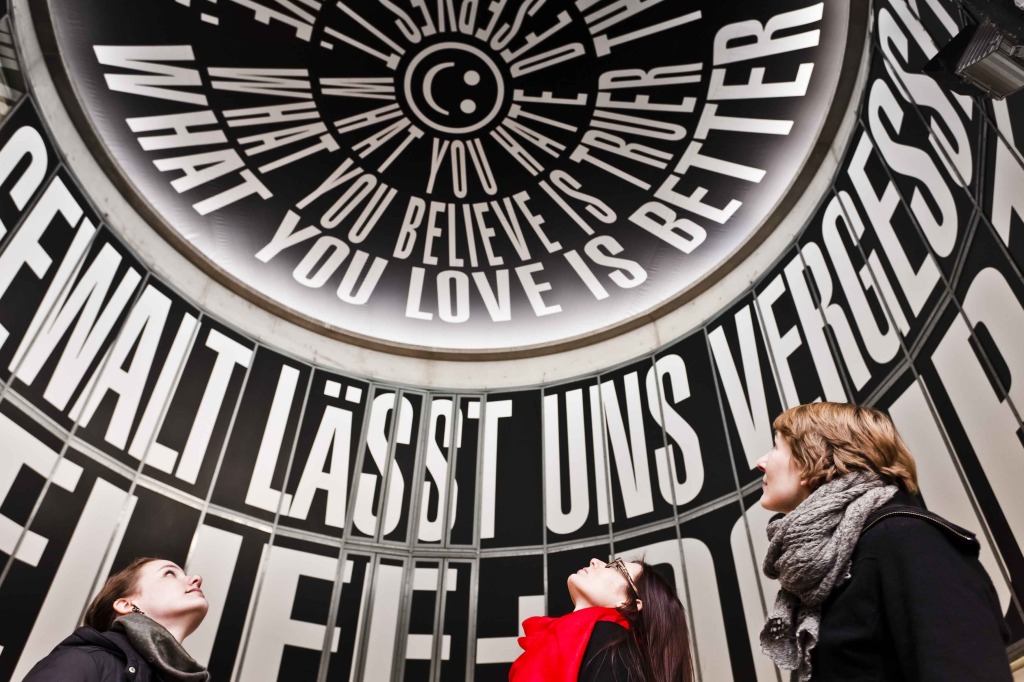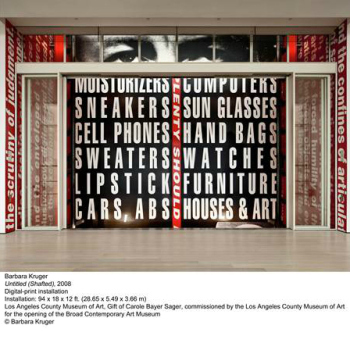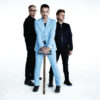Barbara Kruger is one of the world’s most respected contemporary artists, and her art might be among the world’s most recognizable. Her early work was featured in the Whitney Biennial, and then in the late 70’s and 80’s she hit on a signature style: bold, often political or ironic slogans, sometimes superimposed over black and white photographs. She’s installed huge rooms full of text in the world’s major museums, her work has appeared wrapped around public buses, on billboards, and in her recent video work. On November 1st she’ll be honored alongside Quentin Tarantino at the L.A. County Museum of Art’s Annual Art+Film Gala.

Rico Gagliano: Barbara, it is an honor.
Barbara Kruger: It’s an honor to be here.
Rico Gagliano: So let’s go back to the beginning. You studied as a young woman under — among others — the photographer Diane Arbus, who’s another of my favorite artists. Maybe do you have one thing she imparted to you that you’ve taken with you in your career, that you remember her saying?
Barbara Kruger: Remember her saying, no, but… Oh, yes! She actually said to me that I should write more, because I talked like Dorothy Parker.
Rico Gagliano: Meaning in the tone of your voice or in actually what you said?
Barbara Kruger: I don’t know, I haven’t the faintest — I didn’t know who Dorothy Parker was when she said that to me, I was a kid. But I will say that what I learned from Diane was to never point a camera at another human being.
Rico Gagliano: Which is what she did all the time.
Barbara Kruger: That’s right.
Rico Gagliano: That seems counter-intuitive.
Barbara Kruger: That’s right!
Rico Gagliano: How is that what you learned?
Barbara Kruger: Well, because I think that there is a power relationship in pictures and pointing cameras, and I’ve tried to make my work about considerations of power.
Rico Gagliano: So… do you think that she was on a power trip in some way?
Barbara Kruger: No, it’s not about being on a power trip. It’s the power implicit in the mechanism of pointing and shooting.
Rico Gagliano: How did you learn that from her?
Barbara Kruger: Because I felt that my experience with her, plus my experience of working at magazines for so many years, really taught me about how the body can be objectified, and how stereotypes can be solidified.
Rico Gagliano: Let me actually ask you about your magazine work, if I may. You started as a graphic designer, and your later work — particularly the photographs and text pieces — obviously draws heavily on that design. It’s very clean, it conveys these really bold, direct messages almost like advertising. What were your reasons to move into the fine art world? Why not stay in graphic design?
Barbara Kruger: Well, first of all, I should say I admire designers incredibly. I think they have extraordinary ability to solve lots of visual problems. I think the difference is the client relationship.
A designer has to create the images of someone else’s perfection, and an artist can deal with their own possibilities and their own angels and demons.
Rico Gagliano: It’s basically about being able to do what you want to do, it sounds like.
Barbara Kruger: To a degree, yes.
When I was quite young, I really didn’t know how to begin to call myself an artist. I had no undergraduate degrees, I felt sort of marginalized in the art world the way most young women did. When I was coming up, the art world was ten white guys in Lower Manhattan.So, things have changed quite a bit.
Rico Gagliano: Well actually, one of my later questions was going to be: how has the art world changed? But that seems like a huge change. I mean, I would think that in some ways, the art world has changed for the worse, because there’s so much more money in it…
Barbara Kruger: No — you know
I am not a nostalgic person. It was not better “back then,” whenever “back then” was.To me, these are the good old days, not because they’re good, but because we are alive to experience and to change them. So, you know, now there are more artists working globally, people of different colors and sexual proclivities and certain marginalities that were never allowed to be calling themselves artists. So it’s much better now. Yes, the market has changed the art world, that is true, and that’s relatively recent.
Rico Gagliano: If you don’t mind me stepping back into nostalgia mode for just a second though, you have said that the classic film director Sam Fuller‘s work had a huge impact on what you do. Make the connection for me between his stuff and yours.
Barbara Kruger: I think that his use of black and white, his use of expository text, the ridiculous irony in his films, the over-the-topness.
Rico Gagliano: Although I think of him as being, like, almost unhinged. I don’t see your work as being unhinged. It’s actually very specific and measured it feels like to me. Do you feel like it’s over the top?
Barbara Kruger: No, but
I don’t think that we necessarily mirror our influences. I think that there are suggestions made, incremental moments that we might learn from or transform.You know.
Rico Gagliano: Sure, although you mentioned Sam Fuller using text in his movies. You are very well known for doing exactly the same kind of thing, and actually in researching for this interview I kind of geeked out and learned what that font is that you used in a lot of your famed early works — which is something called Futura Bold Oblique?
Barbara Kruger: Futura Bold Ital, yeah.
Rico Gagliano: I also weirdly know that Futura Extra Bold was Stanley Kubrick’s favorite font. What is the appeal of that particular font?
Barbara Kruger: I liked it because… I barely knew what it was called, because I don’t have a design background. I never studied design. So I was never a typeface geek. I just grew up in Newark, New Jersey and then in New York City, and I looked at all the tabloids there when newspapers actually had a presence within our culture in their hard-copy form. And of course when you look at the headlines — The Daily News, The Post — it was all sans-serif.

Rico Gagliano: Yeah, Futura does have that kind of tabloidy, no-frills kind of look to it.
Barbara Kruger: Big, thick, chunky, sans-serif. And I just felt that, you know, I was interested in making work that just reaches out and touches someone. And I think that my early work, without a doubt, was informed by my job as an editorial designer at Condé Nast, and that job morphed — with a lot of changes — into my work as an artist. I use that fluency, you know.
Rico Gagliano: We ask many of our guests the question: tell us something we don’t know. But you are also, in addition to being an artist, a cultural critic — and I was wondering if, maybe instead of something we don’t know, maybe someone we don’t know. Is there someone in the art world you’d like to hep us to?
Barbara Kruger: You know, I never wrote about art. I wrote about movies and television…
Rico Gagliano: I consider that all art, as a film student!
Barbara Kruger: Well, good, me too! Which by the way is one reason I am so honored to be honored with Quentin Tarantino, who I think is an amazing artist, and I’ve loved his work for decades. I can honestly say, some of his films, I’ve sat there and said, “I wish I had done that.”
Rico Gagliano: Really? Which one?
Barbara Kruger: Oh, so many of them. There are moments… that sort of conflation of rich text and dialogue and great imagery, and that sort of combo of brutality and wild humor, I just love it.
 Rico Gagliano: That’s true — I think of your messages as being very serious, but it is often funny.
Rico Gagliano: That’s true — I think of your messages as being very serious, but it is often funny.
Barbara Kruger: That’s really important to me. I mean, you know, humor is a powerful force. I have to say I’m more interested in laughter than smiling. More interested in just sort of out-and-out… What can I say, I’ve been a Howard Stern fan for, you know, 30 years, I wrote an early article about him for Esquire. You know — Sacha Baron Cohen, all the great comics. There’s something so powerful in all that.


